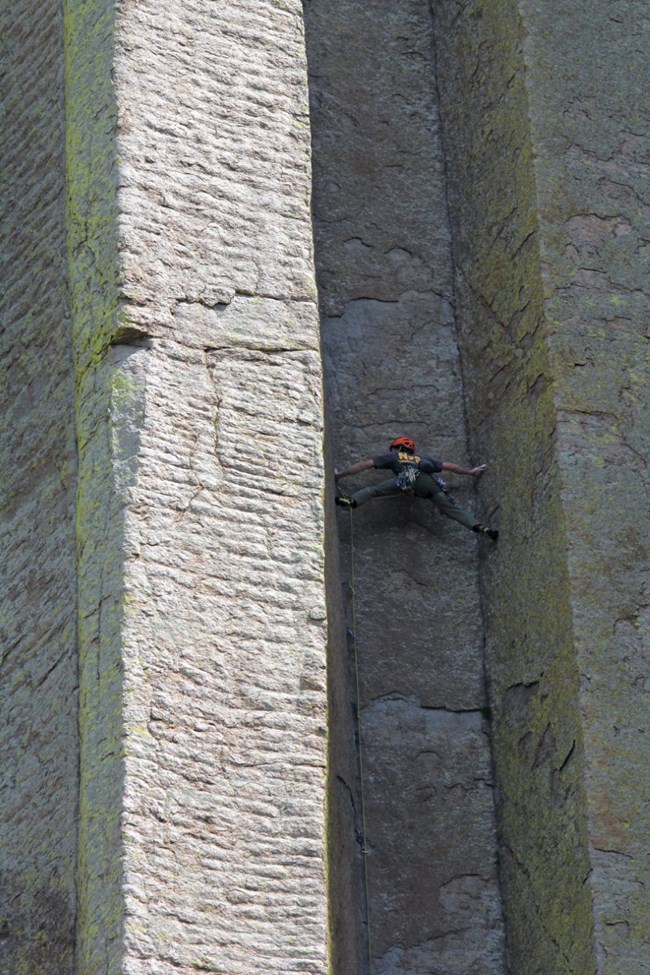Find where you can climb!Current Climbing Closures
NPS photo / Kristen Henderson ClimbingHundreds of parallel cracks divide Devils Tower into large hexagonal columns. These features make it one of the finest traditional crack climbing areas in North America. The cracks vary in length and width: some are wide enough to fit your entire body, others barely have room for your fingers; the longest crack extends nearly 400 feet upwards. Technical difficulty ratings range from 5.7 to 5.13; many modern climbers consider the oldest routes (Durrance and Wiessner) harder than their original ratings. The majority of routes at the Tower are not bolt protected and require the appropriate selection of camming devices or other temporary anchors. The few bolted face climbs that exist were established in the 1980s and 1990s; the condition of some bolts reflect that era. Regulations
The park employs climbing rangers, generally from late spring to early fall. If you have any questions, you may contact the climbing office by phone at (307) 467-5283 x632. Know Before You Go
Climbing Management PlanThe Climbing Management Plan (CMP) for Devils Tower National Monument was released in February 1995. This plan provides direction for climbing activities at Devils Tower to protect the natural and cultural resources of the park. A Climbing Management Plan Update was completed in 2006. The CMP Update clarifies points related to climber education, safety standards and climbing access routes. This update also continues the June voluntary climbing closure (see below). Regulations are essential to protect the natural environment, the heritage and culture of American Indians, climbers, and the general public. The park asks all climbers to act responsibly by knowing and adhering to park regulations. The 1995 Climbing Management Plan and the 2006 CMP Update are available for the public. June Voluntary Climbing ClosureAmerican Indians have regarded the Tower as a sacred site long before climbers found their way to the area. As visitation increased and climbing became more popular, American Indian people have expressed concerns about recreational climbing at the Tower. Some perceive climbing on the Tower as a desecration to their sacred site. A key element of the Climbing Management Plan is the June Voluntary Climbing Closure; this is a compromise reached during development of the CMP by a workgroup that included representatives from climbing and American Indian communities. The National Park Service advocates this closure to promote understanding and encourage respect for the culture of American Indian tribes associated with the Tower. June is a culturally significant time when many (but not all) Indian ceremonies occur. Although voluntary, this closure has been very successful - resulting in a significant reduction in the number of climbers during June. The voluntary nature of the closure hinges on minimizing climbing during this period. Throughout June, the park asks visitors to voluntarily refrain from climbing on the Tower or scrambling inside of the Tower Trail loop. Please consider the closure when planning a climbing trip to Devils Tower. Alternative climbing areas are located within 100 miles of Devils Tower National Monument. The park also encourages you to use resources such as the Mountain Project to locate other climbing destinations. The Access Fund, a national climbing organization, fully supports the voluntary closure and the park's CMP. Commercial Guide ServicesSeveral climbing guide companies hold permits for operating at Devils Tower National Monument. You may contact the park or search the internet for more information. When using a commercial guide service, make certain the company has a valid permit for guiding climbs at Devils Tower. Learn More |
Last updated: April 24, 2025
